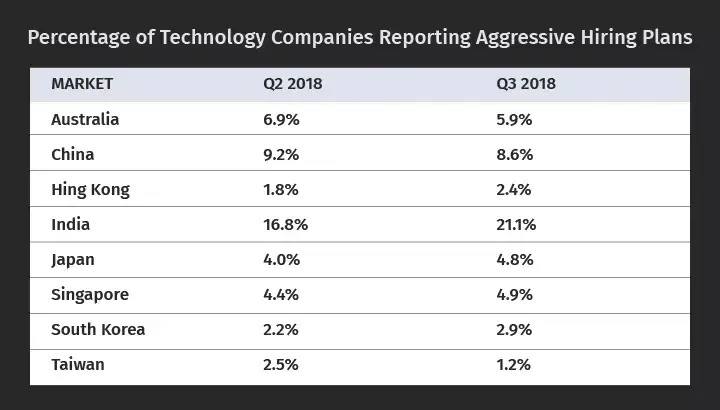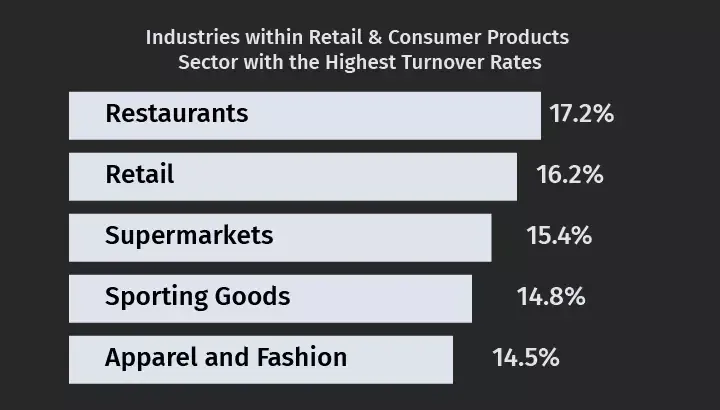Employee Turnover Rate: Causes, Impact, and How to Reduce It
High employee turnover can disrupt productivity, increase hiring costs, and lower morale.
On this page
- What is employee turnover?
- How to calculate employee turnover rate
- Average employee turnover rate by industry
- What high employee turnover really means?
- Causes of employee turnover in the workplace
- How to reduce employee turnover?
- Measuring the true cost of employee turnover
- Reducing employee turnover with Empuls
- Bottomline
The employee turnover rate reflects your company’s ability to retain talent. While some turnover is expected, excessive departures lead to productivity loss, hiring costs, and low morale. With job openings dropping to 8.7 million and separations holding at 5.6 million, businesses must focus on retention strategies.
A healthy turnover rate is around 10% or less, yet 75% of employers struggle to attract and retain top talent. High-performance companies keep top employees with an annual high-performer turnover rate as low as 3% or even zero.
But what drives employees to leave? From poor workplace culture to lack of career growth and work-life balance, the causes vary—but the impact is always significant.
This article explores the causes of employee turnover, how to measure it, and how to reduce employee turnover with practical strategies.
What is employee turnover?
Employee turnover is the number of employees who leave your company over a specific period, typically one year. Although employee turnover usually covers the total number of employees who leave a company, it can also be calculated per department or unit.
Employee turnover doesn’t just refer to employees leaving voluntarily from the company. For example, when an employee is fired due to poor performance or a bad attitude, that counts as employee turnover.
Only, it is involuntary. Some employee turnover is, therefore, inevitable. However, a sudden spike in employee turnover is not because it can be reflective of the bad workplace environment that prompts employees to leave in the first place.
Companies with high turnover are seen as bad places to work. Consequently, companies with a bad reputation struggle to attract the best talent.
How to calculate employee turnover rate
Knowing if your business has a high employee turnover rate is crucial—it’s a key indicator of workplace culture and retention challenges. If your turnover is significantly higher than that of your competitors, you may lose the battle for top talent. Here’s how to calculate it accurately.
1.Turnover Rate Formula (SHRM Recommended):
Turnover Rate=(Average Number of Employees Number of Separations)×100
Identify employee departures: Count all separations (voluntary and involuntary) over a specific period.
Determine the average workforce: Add the number of employees at the start and end of the period, then divide by two.
Apply the formula: Divide the number of departures by the average number of employees and multiply by 100 to get the percentage.
Example employee turnover calculation:
Employees at the start: 200
Employees at the end: 180Employees who left: 20
Average number of employees: (200 + 180) / 2 = 190
Turnover rate: (20 / 190) × 100 = 10.5%
Turnover calculations aren’t always straightforward. You must decide how to account for part-time employees, temporary workers, and employees on leave. The SHRM Turnover Calculation Spreadsheet can simplify this process by ensuring accurate workforce calculations.
Why industry benchmarking matters
Your turnover rate doesn’t mean much unless you compare it to competitors. A "low" turnover rate might still exceed industry standards, signaling a retention problem. Researching average employee turnover rate by industry and location helps businesses understand where they stand and what improvements are needed.
Why employee turnover is a growing concern
Employee retention remains a challenge worldwide. Studies show that half of U.S. employees have considered leaving their current jobs, making it a competitive labor market. Businesses that fail to address turnover risk losing top talent to companies with better workplace culture and engagement strategies.
Tracking and analyzing turnover regularly is essential to improving employee satisfaction and reducing unnecessary attrition—ensuring your company remains a competitive employer of choice.
Average employee turnover rate by industry
Now that you know how to calculate the employee turnover rate, your next question is, what constitutes a low and high turnover rate? The answer will depend on your industry.
It’s difficult to give an ideal employee turnover rate because industry-specific factors also affect employee turnover. What I can give you, though, are the employee turnover jobs and high employee turnover industries.
Let’s dive in:
1. Tech
Tech has had the highest employee turnover rate in recent years. In 2017, it had a 13.2% turnover, according to a LinkedIn study. That’s 0.2% more than the employee turnover rate for retail (more on this later). In previous years, retail had consistently been at the top of the list of industries with the highest employee turnover.
Within the tech industry, some industries have shown the highest turnover rates:
There are specific high-turnover jobs, too. For example, the job of user experience and designer had a turnover rate of 23.3%. This was followed by the data analyst post and the embedded software engineer post, with 21.7% each. However, the high employee turnover rates in the technology industry, in general, may have more to do with staff competition.
As competition in the sector increases for scarce resources, companies offer more competitive salaries and benefits to compete, which prompts some employees to jump ship when they find better opportunities.

The table above from the Radford Global Technology Survey Quarterly Workforce Trends Report shows that, in particular, there has been a spike in the number of companies looking to hire aggressively, particularly in India, where the technology sector is booming.
In other words, while there is a high turnover rate in some fields in tech, these employees leaving still get jobs in the technology industry.
2. Retail and consumer products industry
Historically, the retail and consumer products industry has had a high employee turnover rate. According to the LinkedIn survey, within the retail sector, restaurants had the highest turnover rate, at 17.2%:

Within the retail industry, retail sales personnel had the highest turnover rate, at 19.3%, followed by food service professionals, at 17.6%, and hospitality professionals, at 17.0%.
Although it’s hard to say the main reasons for employee turnover in the industry, the fact that the jobs with the highest turnover are low-level and seasonal may explain a lot. Also, the rise of eCommerce in retail means that fewer people are needed in-store.
This is because many traditional retail functions have been digitized and automated. Online shopping, self-checkout kiosks, and automated inventory management through distribution ERP software have reduced the need for as many in-store staff.
3. Media and entertainment industry
The employee turnover rates in the media and entertainment sectors are constant.
Whether it’s newspapers, online media, sports, or travel and tourism, the employee turnover rate is basically the same according to LinkedIn: from 13% to 13.2%.
The same cannot be said of jobs in the film sector. Animators have the highest turnover rate, at 25.6%, followed by 3D artists, at 22.3%. Marketing specialists are in third place, with a 19.8% employee turnover rate.
The high turnover jobs based on the data are mostly project-based (or have a clear beginning and end, depending on the duration of the movie shoot, for example).
The high turnover rate could explain the exodus of employees. If that is the case, these statistics should be treated with a degree of caution, as it’s not an accurate measurement of employee turnover.
What high employee turnover really means?
There are many, many reasons why employees leave your organization at a high rate - it can be different for every business. But there are a few common factors that you will want to look at that often cause employees to leave.
1. Poor compensation or benefits
If your employees work just as hard as your competitors, but they aren’t getting the same level of pay or benefits, that’s a big reason they might leave. And with the popularity of sites like Glassdoor, employees today have plenty of insight into what their peers at other organizations are earning.
After all, employees accept jobs for many reasons, but the most important is making money to support themselves and their families. If they don’t feel they can do that with you or feel better elsewhere, they’re more likely to leave.
2. Negative workplace culture
Are your employees stressed out, overloaded with work, unappreciated, or subject to too much unhealthy competition? The culture of your workplace has a significant impact on employee retention.
If employees feel your organization shows through your workplace culture that you don’t care about them as people, they’re probably heading for the exits soon. That can mean a culture of overwork, underappreciation, and a culture of poor boundaries, so employees work all hours or culture of unpleasant or harmful behavior.
Employees spend most of their week at work - have you created a supportive culture where people can do their best work or one where they can’t wait to get out the door at the end of the day?
3. Poor career opportunities
You might have competitive pay and great workplace culture, but you notice employees are still leaving more often than you’d like - what’s up? It could be a lack of career opportunities. If employees don’t feel there’s a path for long-term success with your company, that isn’t very encouraging.
They want opportunities to learn new skills, take on new challenges, and grow their careers. That doesn’t mean you need to promote every employee every year - that’s not a reasonable expectation.
But it can help take a hard look at the kind of career development plans and opportunities you’re providing for employees - is there room for improvement, especially for your most promising talent? Helping them see a clear future and plan for getting there can encourage talented performers to stay and continue contributing to your business.
4. When turnover is healthy
That being said - not all employee turnover is bad! A healthy level of turnover brings fresh blood and ideas into your organization. New hires can bring new ways of looking at old problems and enhance how your organization operates. You don’t want things to get stale in today’s fast-moving world, so don’t aim for a turnover rate of zero.
Plus, you sometimes want employees who are not well-suited for their roles or your company culture to select themselves out of your organization and find a place or role that suits them better. That kind of turnover is healthy and should sometimes happen instead of holding onto people who just aren’t working out.
In short, don’t try to get rid of all your employee turnover - make sure it’s at a healthy level and happening for the right reasons.

Build a Culture Employees Don’t Want to Leave
Employees leave when they feel unappreciated. Empuls makes recognition, rewards, and workplace connections effortless, increasing retention and job satisfaction.
Causes of employee turnover in the workplace
I’ve mentioned that some employee turnover rate is inevitable. When employees retire, for example, that’s not within the company’s control. The same can be said of employees deciding to shift careers.
There are, however, reasons for employee turnover that companies can do something about. In this section, let’s look at those:
1. Lack of growth
No one wants to be stuck in the same old job, doing the same old routine. In fact, according to Business2Community, career development opportunities rank third among the non-monetary company offers that make employees stay.
If you want your employees to be in it for the long haul, make sure you make it clear to them from the start that they have a future in the company if they work really hard.
Always remember, your employees are not robots who have no plans. People have professional goals and want to advance in their chosen careers. If the job they have now isn’t helping them attain those goals, then leaving won’t be as hard.
2. Too much work
If you ask former employees of companies with high turnover why they left, too much work is probably one of the reasons they will give you. Everyone loves a job that pays the bills, but not if it leads to stress, and worse, even sickness.
Too much work results in burnout and that, according to the Harvard Business Review, costs about $125 billion to $190 billion a year in healthcare spending in the US. The real costs on the company, however, can be even greater, with low productivity as a result of lost talent.
In other words, all companies should respect their employees’ time, too. There’s a reason employees use an employee time clock app to log in and out of work. Once the clock strikes 5 p.m., they can basically do whatever they want. But that also means they’d have to be in the office at exactly 9 a.m. the following day.
3. Lack of recognition
Giving credit where credit is due is key to employee retention. According to The Balance Careers, 55% of employees believe employee recognition will make them feel valued. Of the study's respondents, 58% also said employee recognition will improve employee engagement in the company, a crucial element for employee retention.
Then there’s the relationship between recognition and productivity. According to Gallup, 69% will work harder if they felt their efforts were being recognized. That translates to higher company productivity overall and increased profit.
4. Little opportunity to decide
Managers should manage their teams, but that doesn’t mean they should “suffocate” them. Of course, I don’t mean that in the literal sense of the word. I meant they shouldn’t micromanage employees to the point that they can no longer do anything without the manager’s approval.
If employees have little opportunity to decide, morale is affected badly. This is because they become frustrated with the loss of autonomy and lose the desire to go the extra mile when given a task. And when there’s low morale, there’s low productivity.
When employees are given little opportunity to decide, they also become too dependent on the manager; they no longer think outside the box and grow.
5. Poor employee selection
Employees sometimes leave companies because it’s just in their DNA to do that. Although there is nothing companies can do about a person's DNA, they can still control the people they hire. HR should hire, not just the candidate with the skills for the job.
It should also look at the candidate’s attitude and values. If they don’t match the company values, then even if the candidate is the best for the job skills-wise, might as well go for the next-best one who is likely to be happy in your office. Because when that person is happy, that person is more likely to stay.
How to reduce employee turnover?
Now that you know the primary reasons for employee turnover, let’s discuss the strategies to reduce employee turnover and prevent your employees from leaving:
1. Ensure a clear career path for employees
As the HR, you should also work closely with the company managers to identify employees with potential. Once identified, their immediate supervisor should guide them so they can have the necessary skills to grow. The idea is to help them comply with the requirements needed to climb the corporate ladder.
On your part, provide managers and employees with potential the necessary support they need. You can, for example, sponsor training and seminars. Organize events with senior company officials as resource speakers and employees as the audience, too.
This way, your employees will know more about how the management started out in the organization and how, with hard work, they grew and reach success.
2. Ensure good work-life balance
Don’t make it all about working with your employees. Remind them to take their lunch breaks. Take them out on company outings once in a while. Organize social events in the office. Make it clear to them that while the company values productivity, it’s not at the expense of their health.
Make sure you monitor the workload given to employees, too. If a team member is bogged down with work, some of the tasks can be assigned to other members of the team who can do it just as well. Delegate, so not one member of the team becomes overworked and becomes so frustrated the person leaves.
3. Improve employee engagement through communication
Lack of communication and transparency fuels disengagement, making employees feel disconnected from the company’s mission. Empuls’ social intranet and survey tools help bridge this gap by creating an interactive, open communication space where employees can share feedback, participate in discussions, and stay informed.
Regular pulse surveys provide real-time insights into employee sentiment, helping HR leaders address concerns before they escalate into turnover. When employees feel heard and involved, they are more engaged and less likely to seek opportunities elsewhere. A connected workforce is a retained workforce.
4. Recognize and reward employees from time to time
Employees are more likely to stay when they feel valued for their contributions. Regular appreciation—whether through verbal recognition, bonuses, or career growth opportunities—creates a positive work environment where employees remain motivated and engaged. Recognizing achievements not only boosts morale but also reinforces company values and encourages high performance.
This is where Empuls helps organizations build a culture of recognition with real-time appreciation, personalized rewards, and milestone celebrations. With features like peer-to-peer recognition, automated incentives, and service anniversary rewards, Empuls ensures employees feel acknowledged at every stage of their journey. By making recognition a seamless part of daily workflows, businesses can enhance engagement, strengthen loyalty, and significantly reduce turnover.
5. Give credit where credit is due
It’s always a good idea to recognize hard work. When companies do this, they make employees feel valued and motivate employees to work even harder. As the HR, you can, for example, organize a special recognition day for employees who stood out during a given period.
For example, recognize in a company-wide event the company’s salesperson who sold the most products during the first quarter of the year. Or give extra vacation leaves to that person who was never late to work. You can offer monetary rewards if you can, too. Be creative.
Look for trends in employee rewards programs and be inspired. If you give credit where credit is due, you will keep your employees happy and engaged. And leaving the company for them will be out of the question.
6. Tell managers not to micromanage
Don’t get me wrong. Hands-on managers are great. What companies don’t want, though, are managers who are overly hands-on, and their co-workers can’t get anything done without them. As the HR, brief your managers on how the company would like things done.
Although team management is necessary, it shouldn’t be to the point the entire workflow gets bogged down because the managers need to approve everything. Tell them to give employees some leeway to decide things. This way, employees will feel they have something to contribute. And they develop their decision-making skills.
7. Do the selection process right
Don’t just breeze through the selection process when you’re looking to fill a position in the company. The selection process is there, so companies will be spared from hiring candidates who are not a good fit in the company. So take your time and conduct the interview properly with an effective talent management process.
Ask relevant questions. You want to gauge the candidate’s skills AND the person’s attitude and personality. Hiring someone just because that person was the first one with the skills required to apply for the job is never a good idea. You have to wait for the right person. Not force one candidate to be the right person so that you can announce the position has been filled.
8. Offer competitive compensation and benefits
Salary plays a key role in retention, but it’s not just about offering a competitive base pay. Employees today expect comprehensive benefits that go beyond a paycheck. Companies should provide healthcare plans, wellness perks, performance-based bonuses, and tax-free fringe benefits to enhance financial security and job satisfaction.
Additionally, benefits like tuition reimbursement, childcare assistance, and flexible spending accounts make employees feel valued and supported, increasing their commitment to the organization. Employers who invest in well-rounded compensation packages create a workplace where employees feel financially stable and motivated to stay.
Measuring the true cost of employee turnover
Ask any employee, HR pro, or business guru, and they’ll tell you that, yes, employee turnover is bad. Of course, it makes sense - employees leaving your business isn’t a good sign!
You don’t need an MBA to tell you that. But few people know the actual cost of employee turnover. And that’s a problem because turnover costs businesses much more than they know.
If you don’t know what too much turnover is costing you, you won’t understand the urgency of fixing the problem.
So let’s take a look at the actual costs of low retention to your bottom line.
1. The financial cost
The most accessible cost of turnover to calculate is the financial toll it takes on your business. Employees are eventually an asset to your company, but at the beginning of their career with you, they are at a cost.
Recruiting, hiring, and training all incur monetary costs - and you can’t get around that spend. Plenty of data is available on how much it costs to replace just one departing employee, depending on their level and length of time in their role.
So how much does it cost to replace an employee who leaves in real dollars? There are many ways to estimate the cost. Still, a good benchmark is 50% of the salary for entry-level employees, 125% of the salary for mid-level employees, and over 200% of the salary for a senior executive. That’s a lot. That’s tens of thousands of dollars, at the minimum, you need to spend every time a single employee leaves your company.
Of course, this rate varies by industry and company - you can calculate the exact turnover cost for your business with this spreadsheet calculator from SHRM. But that fiscal cost, stunning as it might be, is not the only cost you incur with every departure.
2.The knowledge cost
Every year that an employee works for your company, they gain more knowledge. They learn things like the necessary processes and procedures for getting things done the way your business does them.
They gain experience in working with your clients and customers and build relationships with them. They build relationships with each other. They go from needing training to being able to train other employees. They mature into management roles. They increase their invaluable institutional and industry knowledge.
When they leave, all of that leaves as well. Unlike tools like printers, office chairs, or your breakroom fridge, employees are an appreciating asset. They gain more value with every year they stay at your company, because of all they are learning and applying every day.
So, if you’re regularly losing employees to competitors after just two or three years, you’re also losing that long-term learning employees are absorbing and passing onto newer hires too. You also lose the valuable relationships that your best employees develop with your customers.
You might end up losing one or more clients along with an employee - and that can be devastating for your business. You can’t afford to let your star performers slip away for preventable reasons.
3.The morale cost
Let’s face it - if you regularly have employees quitting after just a couple of years - or a couple of months - you probably have something going pretty wrong in some part of your employee experience. Building strong employee morale isn’t easy when workers are always walking out the door.
High employee turnover rates can be both a cause and a symptom of low employee engagement and morale. If employees don’t like coming to work every day and don’t feel engaged in their work, they’re more likely to leave.
And we have probably all had the experience of being on a team where person after a person leaves - and it starts to feel pretty ominous.
The employees left behind have to pick up the slack, they mourn their lost relationships with the departed coworker, and they begin to wonder if they should leave too. It can cause a vicious cycle of ever-increasing turnover until you’re left with only the newest and least-experienced employees who have nowhere else to go.
Reducing employee turnover with Empuls

High employee turnover doesn’t just impact recruitment costs—it affects team morale, productivity, and overall company culture. Employees don’t leave just for better pay; they leave when they feel undervalued, disconnected, or unheard. Empuls helps businesses create an environment where employees feel motivated to stay.
Instead of reacting when employees resign, Empuls enables companies to proactively engage and retain talent through:
- Recognition & rewards: A culture of appreciation fosters loyalty. With Empuls, employees receive timely recognition for their contributions, making them feel valued.
- Real-time feedback & surveys: Understanding what employees need before disengagement sets in is key. Empuls’ engagement surveys uncover hidden concerns and provide actionable insights.
- Social intranet for connection: A connected workplace reduces isolation and strengthens company culture. Empuls’ social intranet promotes open communication and collaboration, even in remote teams.
- Personalized employee perks: Offering benefits that align with employee preferences—like wellness programs, learning opportunities, or milestone rewards—enhances job satisfaction and retention.
When employees feel heard, appreciated, and engaged, they choose to grow within the company rather than look elsewhere. Empuls provides the right tools to build a workplace where employees stay, thrive, and contribute to long-term success.
Bottomline
No one thinks high employee turnover rates are good for business. But until you truly know how much each departing employee costs your company in recruitment and training dollars, lost institutional knowledge, and team morale, you can’t start to develop effective solutions. The good - and bad - news?
Most employee turnover is preventable. Once you’ve calculated the actual cost of losing employees, you can start to strategize about the best ways to retain them instead. And then you’re on the road to building a sustainable, successful business that your employees love to work for.


















